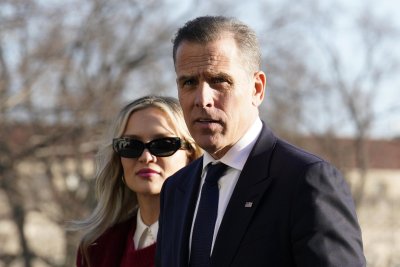Column: A lump of coal for Trump, a governor focused on California and other Christmas wishes
SACRAMENTO — I’ve got a wish list for Santa and it’s topped by this urgent request: a remodeled president with at least an ounce of humanity and humility.
Maybe a Ronald Reagan type. I’m not referring here to ideology or policies. Just common decency, someone who acts presidential.
I know, forget it. That’s beyond Santa’s reach. It would require a miracle. And that’s not likely to happen with President Trump, who seems increasingly to be auditioning for the devil’s disciple.
But you’d think as we approach our nation’s 250th birthday, America could be led by a president who at minimum doesn’t publicly trash the newly deceased.
Someone who follows the basic rules of good behavior and respect for others that our mothers taught us.
For Trump, the Golden Rule seems to be only about cheapening the historic Oval Office with tasteless gilded garnishments, turning it into an extension of his Mar-a-Lago resort. That’s what you’d expect from someone who would pave over the lovely Rose Garden.
But I’ve gotten off the point: the despicable way our unhinged president treats people he deems the enemy because they’ve criticized him, as we’ve got a right and often a duty to do in a democratic America.
What our president said about Rob Reiner after the actor-director-producer and his wife Michele were brutally stabbed to death in their Brentwood home, allegedly by their son Nick, should not have shocked us coming from Trump.
After all, this is a guy who once said that the late Sen. John McCain, a Navy pilot shot down over North Vietnam, tortured, maimed and held captive for five years, was “not a war hero … I like people that weren’t captured.”
He also once mocked a disabled New York Times reporter at a campaign rally, saying: “The poor guy, you ought to see this guy.” Then Trump jerked his arms around imitating someone with palsy.
He frequently attacks female reporters for their looks.
Recently, he called all Somali immigrants “garbage. … We don’t want them in our country.” As for Minnesota Rep. Ilhan Omar, a onetime Somalian refugee, “she’s garbage. Her friends are garbage.”
But even with Trump’s sordid history of insults and insensitivity, what he disrespectfully said about Reiner was stunning. He implied that the Hollywood legend was killed by someone angered by Reiner’s criticism of Trump. Again, everything’s all about him, in this egotistical president’s mind.
Trump said the Reiners died “reportedly due to the anger he caused others through his massive, unyielding and incurable affliction with a mind crippling disease known as TRUMP DERANGEMENT SYNDROME.”
Then the next day, he doubled down, telling reporters that Reiner “was a deranged person. … I thought he was very bad for our country.”
Topping off the holiday season for Trump, he orchestrated the renaming of Washington’s classy John F. Kennedy Center for the Performing Arts after himself. From now on, it’s to be called the Trump Kennedy Center.
What’s next? The Washington National Cathedral?
OK, next on my Santa’s wish list is a governor who spends his last year in office trying to improve California rather than his presidential prospects. Actually, he could do the latter by doing the former: making this state a better place to live and proving his ability to sensibly govern.
Too many of Gov. Gavin Newsom’s projects fall flat, collapse or are a waste of energy and dollars.
One recently announced Newsom venture particularly is questionable. He seems to be using state resources and tax money to expand his overdone war with Trump rather than helping Californians with their everyday lives.
The governor unveiled a new state-run website that tracks what his office calls Trump’s “criminal cronies.” It catalogs major criminal convictions that were followed by Trump pardons — from Jan. 6 rioters to former politicians and business tycoons.
Yeah, well, so what? I suppose some people may be interested in that. But at taxpayers’ expense? Will the information lower gas prices? Make it easier to buy a home? Pay for childcare?
Here’s just one example of a Newsom program that failed miserably:
Early in his administration the governor announced with great fanfare that he was increasing fees on telephone service to pay for upgrading California’s 911 emergency communication system. The state spent $450 million, couldn’t make the new stuff work and abandoned the project, the Sacramento Bee reported after a lengthy investigation. Now they’re apparently going to start all over.
A little hands-on supervision by the governor next time could help.
Also on my wish list: A Legislature that doesn’t hibernate through the winter and wait until late spring before starting to push bills.
They’d need to change legislative rules. But Democrats with their supermajorities could do practically anything they wanted — even work earnestly during the cold months.
Either that or just stay home.
Included in the gift package: Legislation focused more on quality and less on quantity. This year, the Legislature passed 917 bills. My guess is that 100 meaty measures would have sufficed.
There’s one more item on my Santa list that all of America needs: A new casual greeting to replace “How ya doing?”
Nobody really wants to hear how most people are doing and they probably don’t want to candidly say anyway — not in an elevator, on the sidewalk or in a restaurant.
“Bad stomach flu,” I might honestly answer. You really want to hear that while chomping on a hamburger.
So, what do we replace it with?
Maybe simply: “Good morning.” Or “Go Dodgers.”
Or “Go Trump” — far away out of earshot.
What else you should be reading
The must-read: Ronald Reagan biographer, legendary California journalist Lou Cannon dies
The TK: Newsom taps former CDC leaders critical of Trump-era health policies for new initiative
The L.A. Times Special: In a divided America, Rob Reiner was a tenacious liberal who connected with conservatives
Until next week,
George Skelton
—
Was this newsletter forwarded to you? Sign up here to get it in your inbox.









